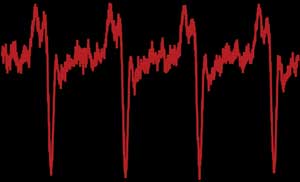
An unexpected dark pulse laser
Sometimes what isn’t
there can be as interesting as what is. In working to develop mode-locked quantum
dot diode lasers, researchers have discovered something unforeseen: a dark pulse
laser. The device emits a steady beam of light, with periodic dips that are like
dark pulses in the continuous bright background.
Dark pulse lasers are new, so applications for them are still
a matter of speculation. But research leader Steven T. Cundiff, a physicist with
the Gaithersburg, Md.-based National Institute of Standards and Technology (NIST),
noted that if they can achieve the right performance, dark pulse lasers could prove
beneficial. Some of the possible applications, for instance, are related to optical
frequency combs and optical atomic clocks. “The continuous-wave background
may provide a single strong comb line that could be used to probe a quantum transition,
and then the train of dark pulses could be used to transfer that frequency information,”
Cundiff said.
There are some potential telecom applications because of the lack
of dispersion and the linearity during transmission of the dark pulses. However,
he does not anticipate much use of dark pulse lasers in this area, largely because
the industry already has solutions for fiber dispersion and linearity problems.

The light output from a dark pulse laser nearly vanishes every 2.5 ns, as shown in this
colorized trace. Courtesy of the National Institute of Standards and Technology.
Cundiff and other researchers from NIST and from the University
of Colorado at Boulder developed the dark pulse lasers. As noted in an Optics Express
paper published in June 2010, they fabricated the device in a semiconductor cleanroom,
burying an indium gallium arsenide quantum dot in the core of a 5-mm-long gallium
arsenide ridge waveguide that acted as the gain medium.
They also created a saturable absorbing medium by damaging semiconductor
wells in material they grew through molecular beam epitaxy. Because of its placement
and optical properties, this acted as an end mirror to the laser cavity.
With careful alignment of the various components, they could start
lasing action by injecting 60 mA of current into the device. When they looked at
the device output, they found dark pulses, an unexpected result. These pulses could
be as short as 90-ps duration, and in them, the laser intensity could drop to as
low as 30 percent of the normal steady-state output.
These results can be predicted using the standard equations that
describe mode-locked lasers. Cundiff noted that the researchers had to generalize
the equations a bit to include new terms, such as one attributable to the electrical
pumping of the quantum dots.
Dark pulse lasers have been built before, using mode-locked fiber
lasers. However, the shaping of dark pulses in such lasers is dominated by nonlinearity
and dispersion in the fiber. In contrast, simulations suggest that a quantum dot
dark pulse will be largely shaped by the saturable absorber located at the end of
the device. That could make tailoring of pulses to a specific application easier.
In addition, the quantum dot approach offers other pluses, Cundiff
said. He listed three key advantages as compared with dark pulse fiber lasers: greater
efficiency, smaller size and “potential diversity in wavelengths, because
quantum dots can be grown to operate at many different wavelengths.”
He noted that his group is not now actively working in this area.
Instead, it is concentrating on continued research into and development of mode-locked
quantum dot diode lasers.
Published: September 2010